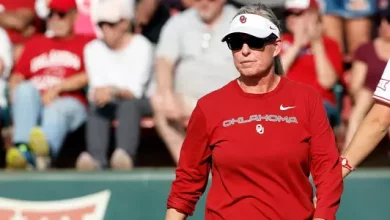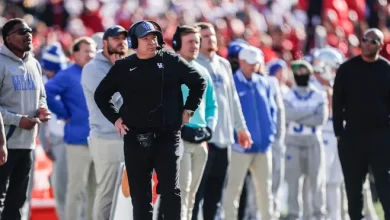JJ Watt speaks out on the ‘preposterous’ transfer portal timeline: “You’re literally cannibalizing your own sport”

The landscape of college football has undergone dramatic changes over the past few years, and one of the most controversial aspects of this transformation is the rise of the NCAA transfer portal. What was initially designed as a tool for student-athletes to explore new opportunities has, in many ways, turned into a source of chaos, with coaches, players, and fans alike grappling with the effects of this new system.
At the forefront of this debate is JJ Watt, one of the most decorated and respected athletes to come out of college football in the last decade. Watt, a former standout for the Wisconsin Badgers, an eight-time NFL Pro Bowler, and one of the most dominant defensive players in recent memory, has recently voiced his concerns about the current state of the transfer portal. In particular, Watt has taken aim at the timing of the portal’s opening and the way it has impacted the sport as a whole.
In a recent interview, Watt described the current transfer portal system as “preposterous,” adding that it has led to a situation where college football programs are in a constant state of flux, with teams regularly losing and gaining players mid-season. In his opinion, this instability is harming the integrity of the sport and its competitive balance. “You’re literally cannibalizing your own sport,” Watt remarked, acknowledging the frustration that many fans, coaches, and players feel in this era of unprecedented player movement.
Let’s break down Watt’s critique of the transfer portal, its implications for the sport, and the broader debate surrounding the future of college football.
The Evolution of the NCAA Transfer Portal
Before delving into Watt’s criticism, it’s important to understand how the transfer portal has evolved over the years.
The NCAA Transfer Portal, which was introduced in 2018, was initially intended to give college athletes more control over their careers. It allows athletes in all sports to declare their intent to transfer from their current school to another, providing them with a clearer path to find new opportunities without having to sit out a full season. This was seen as a victory for player autonomy, a step towards offering athletes more freedom in making decisions that could impact their future.
Under the previous transfer rules, athletes who transferred from one school to another often had to sit out for a full year before being eligible to play. The new transfer portal eliminated this rule, allowing players to immediately become eligible at their new school if the receiving program accepted them. In theory, this was designed to allow athletes more freedom and flexibility.
However, since its inception, the transfer portal has sparked widespread debate. While many advocates believe it empowers athletes, others, like Watt, argue that the system has become problematic. Over the past few seasons, the number of players entering the transfer portal has exploded. As of 2024, over 1,000 players have entered the portal annually, which has created a state of constant churn in college football rosters.
The “Preposterous” Transfer Portal Timeline
In Watt’s recent comments, one of his primary criticisms was the timing of the transfer portal windows. According to Watt, the portal’s current schedule creates instability for college football programs, forcing coaches to constantly deal with roster turnover, and leaving teams scrambling for replacements.
The transfer portal has two primary windows each year: one during the offseason, typically from December to mid-January, and another following the spring semester, from May to early June. These windows, while giving athletes a clear structure, have led to several unintended consequences:
- Mid-Season Disruption: One of Watt’s biggest issues with the transfer portal is the timing of these windows. The portal opens for a brief window after the end of the regular season, allowing athletes to declare their intent to transfer while still technically in-season for their current team. This has created a situation where players are leaving mid-season or immediately after bowl games, which disrupts the flow of a team’s preparation for the postseason.
- Recruitment Chaos: During these windows, coaches are not only tasked with finishing out their own seasons but are also trying to manage the recruitment of players in the portal, while also recruiting high school talent. This overlapping cycle forces coaches into a perpetual state of recruiting fatigue, where they have less time to focus on team development or long-term strategies.
- Uncertainty for Players: For players, the transfer portal timeline can be equally confusing. Once a player enters the portal, there is no guarantee that they will be picked up by another school. Many athletes find themselves without a clear path forward, facing a season of uncertainty as they wait for new opportunities. The uncertainty and timing of the portal have led to an environment where players may make rash decisions based on emotion or external pressures rather than carefully considered, long-term career plans.
“Cannibalizing Your Own Sport”
Watt’s statement that college football is “cannibalizing its own sport” speaks to the broader issue of long-term stability and competitive integrity in the college football world. While the transfer portal offers individual players more freedom, it has the potential to harm the sport in several ways:
- Program Inconsistency: Constant roster changes mean that coaches have less time to develop team chemistry and focus on building a cohesive unit. This affects a program’s ability to sustain long-term success, as teams become less reliant on building up their own players and more dependent on bringing in new talent. Watt argues that this disrupts the natural progression of college football teams, where consistency and continuity are essential for building championship-caliber squads.
- Devaluation of Player Development: Historically, college football programs prided themselves on player development, where athletes were given the opportunity to grow and mature over several years. The transfer portal, however, has de-emphasized this process by giving players the option to jump to other schools in search of immediate playing time. While this may be beneficial for some athletes in the short term, Watt believes it ultimately harms the broader culture of college football by undervaluing the importance of long-term commitment and development.
- Unequal Access to Talent: One of the most significant concerns with the transfer portal is the way it disproportionately affects schools with fewer resources. Power Five programs like Ohio State, Alabama, and Georgia have the facilities, reputation, and financial backing to attract high-level talent through the portal. However, smaller programs may struggle to compete for players, as they are often seen as stepping stones for those looking to move up the football ladder. Watt’s critique centers around the notion that this system creates an unfair advantage for the biggest programs, undermining the parity that makes college football so exciting.
The Impact on Recruiting and Coaching
Another significant aspect of Watt’s critique is the added pressure the transfer portal places on coaching staffs and recruiters. Coaches have always had to balance recruiting high school talent with building relationships with current players, but the introduction of the transfer portal has introduced a new layer of complexity.
- Coaches’ Time Management: With the increase in player movement, coaches are now forced to recruit on two fronts: high school athletes and players in the transfer portal. This can leave less time to focus on developing the talent already within the program. Additionally, teams have had to implement more robust support systems for incoming transfers, adjusting to the personalities and playing styles of new athletes in a short amount of time.
- Short-Term Success vs. Long-Term Growth: The transfer portal rewards immediate success over long-term development. As Watt points out, the focus has shifted from building programs around players over several years to relying on transfers to fill gaps and plug holes in the roster. This strategy may lead to short-term success but can ultimately stymie long-term growth and sustainability.
What Needs to Change?
While Watt has been vocal about his concerns, he is not alone in his criticisms. Many coaches, including Nick Saban, Dabo Swinney, and Kirk Ferentz, have expressed similar frustrations with the current transfer portal system. The consensus seems to be that changes are needed, but what form should they take?
- Shorter Transfer Windows: Some have suggested shortening the transfer window to limit mid-season departures and ensure that players make more deliberate and thoughtful decisions about their future.
- Mandatory Sitting Out Period: Reverting to the rule that required players to sit out for a season after transferring could create a more stable environment. This would encourage athletes to stay at their original schools longer, allowing for deeper team cohesion and development.
- Better Support Systems for Players: Ensuring that players have access to professional advisors, coaches, and mental health professionals during the transfer process could help mitigate the uncertainty and anxiety that many players experience when entering the portal.









